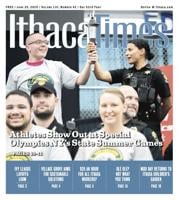The best description of the location of Ithaca was coined by then-Cornell President Frank Rhodes. “Ithaca,” he said, ‘is centrally isolated.” To understand the factors that support Ithaca’s unusual culture, you have to start with the fact that we are in the middle of beautiful rural lands and communities that are far from any interstate. If Ithaca is 10 square miles surrounded by reality, that reality is not that of our rural neighbor communities. (Fair disclosure: when the rush and bustle of Fall Creek gets just too intense for me, I repair to my home in the quiet woods in Lodi, or in adjoining Hector where my family has lived since 1804. That is reality, surely, but the good kind.) The Reality that Ithaca distinguishes itself from is the world of interstates and all the corporate chain enterprises that spring like toadstools around the exits. Because we are far from that Reality, we don’t have a lot of those toadstools here. Neither does Watkins Glen.
Francis Perkins, key architect of the New Deal and the first female cabinet member, arrived at the Industrial and Labor Relations School in the nineteen fifties, and said the same thing. “Ithaca,” she wrote, “is the most isolated place on the Eastern Seaboard.”
Sixty years later, The Daily Show’s Jon Stewart was driven up from New York to give a speech. When they got off the interstate at Whitney Point and drove the rest of the way on a two-lane, Stewart was amazed. What city in New York can one not reach on an interstate? Where you drive down a state two-lane through farms and fields and little villages? Only Ithaca. You can’t take a four-lane from Reality to here. You have to go through a two-lane Reality filter.
Tolerance is an Ithaca civic virtue. We didn’t invent this. The Statue of Liberty proclaimed this as an American virtue. Other towns in our country remember this, too. When I was a kid, this lesson in civics was part of every public school curriculum. I am full of admiration for Schuyler County for stopping the gas storage facility. Whatever names they (and I) might be called for being against progress, they have shown leadership as truly American citizens, like we were told we were supposed to become, someday.
In 1972 both Ithaca city leaders and New York State agreed that Ithaca needed a new four-lane highway. It was to be only 3 1/2 miles long, untangle the octopus, and end at the hospital. In most places such a road would have been put right in. But in cranky, progress-opposing Ithaca, citizen’s opposition to this road sprung up and sustained the fight for 15 years, long enough for the state to finally give up and go away. Back in those days I was once in the city planner’s office. On the wall there was a cartoon of two-lane Rt 13 going up to Lansing, with a mammoth New York State road-building machine poised threateningly at the top of the hill.
Ithaca was keeping it at bay.
Eventually the West end was re-figured with Rt 13 expanded to four lanes. The octopus was finally untangled and replaced with what local wags called ‘the giant squid.” I must confess that after many years threading the squid, I still find myself leaving town on 79 rather than 96, and have to take the connector on Vinegar Hill to get back right. Maybe it’s just me that’s still confused.
Ithaca is still a place that you have to reach by state routes: those early numbered highways that led from one city to another. At the time that the state routes were established, you travelled to and from Ithaca by train. Roads were rutted dirt and mud. State routes were the interstates of their day. I still remember old farmers in Hector who gave you directions by telling you to “get up on the state route.” It was like getting on Rt. 81 today. Up on the state route you could really make time.
State routes are now the old, red lines on a highway map. You are not going to take the state route through Binghamton, as I did as a child. But if you want to come to Ithaca for its unique mix of education, arts, civic sense and hospitality to strangers of all backgrounds and languages, you have to get here the same way that you did in the 1930s if you didn’t take the train. You have to take a state highway.
This is why we aren’t ringed by interstates with their Burger Kings, chain motels, and shopping malls.
There is considerable controversy about a building boom going on downtown and Collegetown. Will this raise rental prices to drive out locals to the cheaper periphery? I lived on Sanibel Island, Florida, where this took place at lightning speed after the bridge to the mainland went in. People who had lived and worked on the island for generations were all driven “off island.” I sure hope my neighbors and I don’t find ourselves squeezed off island. I worry also if all those prosperous new residents may want an improved road to get here, someday.
If so, I hope that their exposure to Ithacaculture will show them something. Maybe they will see that being able to get to Ithaca only on two-lane roads is our greatest protection (seconded by the winter weather) against a massive, antibiotic-resistant infection of Interstate Reality. People here seem inclined to think that rather than building more roads, it might be simpler to ride a Lime Bike. Just don’t try to ride them up the steep hills you have to go up to get out of here for anyplace else. Hook your bike to the front rack of a TCAT bus, and ride up until it’s more flat. Then it’s easy: by bike or by car, get up on the State Route and you’re good to go. Just watch out for the speed trap in Greene.
David B. Schwartz, Ph.D., lives and practices psychotherapy in Fall Creek. His website is: www.sidewalkpsychotherapist.com


















(0) comments
Welcome to the discussion.
Log In
This is a space for civil feedback and conversation. A few guidelines: 1. be kind and courteous. 2. no hate speech or bullying. 3. no promotions or spam. If necessary, we will ban members who do not abide by these standards.